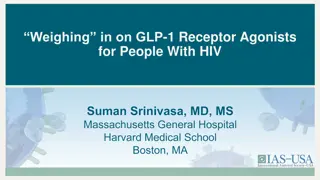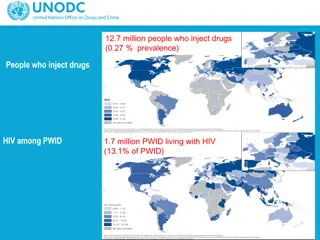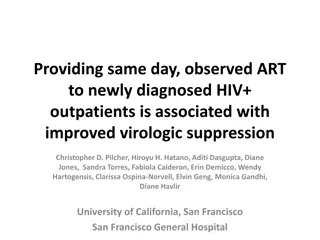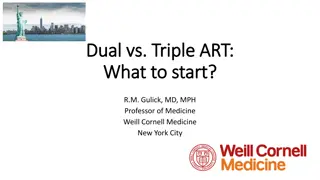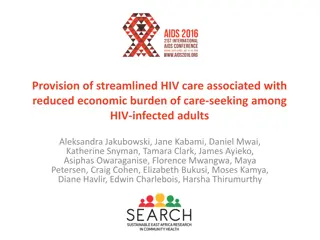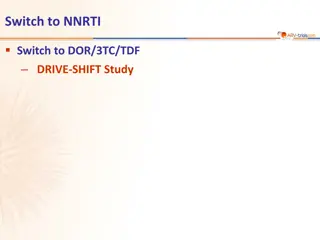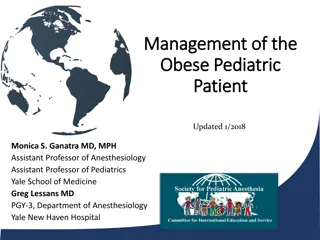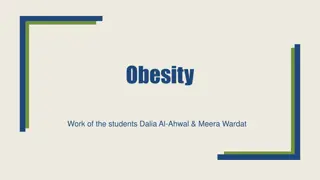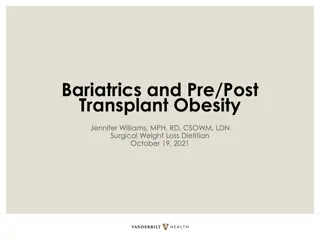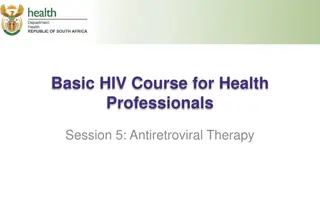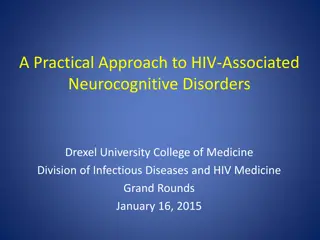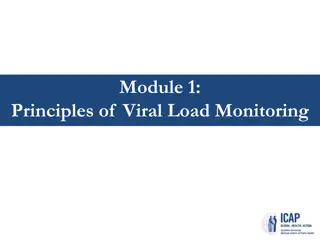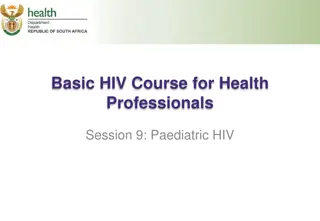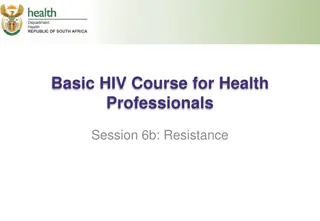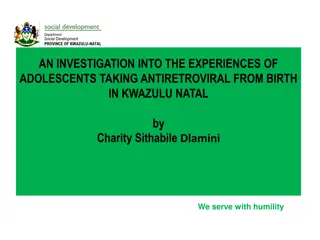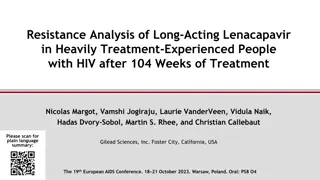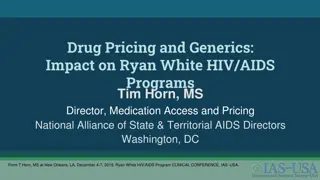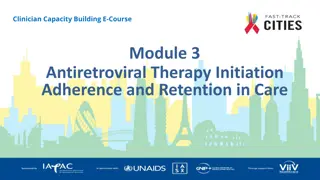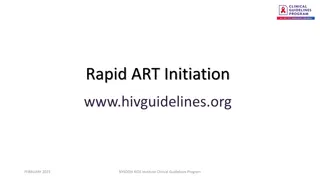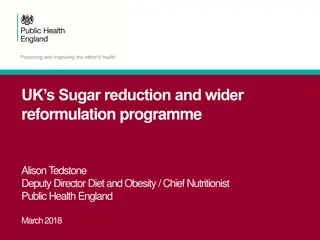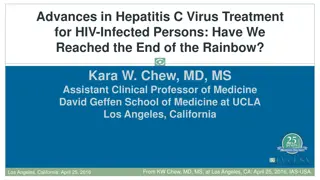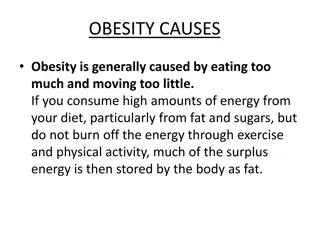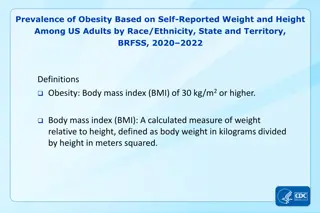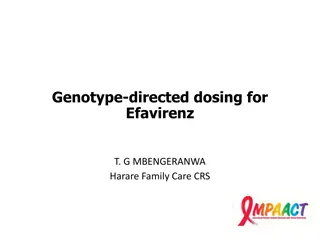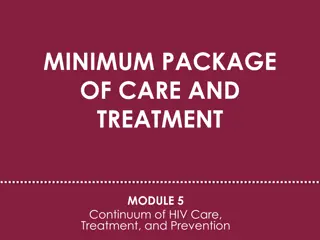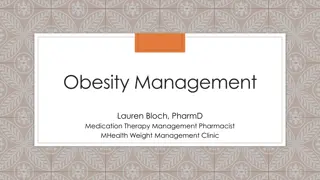Impact of Antiretroviral Treatment on Weight and Obesity in HIV Patients
Dolutegravir (DTG) treatment has shown associations with weight gain and clinical obesity, particularly in black individuals and women. In contrast, tenofovir disoproxil fumarate (TDF) is linked to lower body weight compared to other treatments. Trials like ADVANCE and NAMSAL have provided insights into the effects of different antiretroviral regimens on body weight and body mass index. Addressing weight changes in HIV patients is crucial due to the significant clinical implications of obesity, such as reduced life expectancy and increased risks of cardiovascular and metabolic diseases.
Download Presentation

Please find below an Image/Link to download the presentation.
The content on the website is provided AS IS for your information and personal use only. It may not be sold, licensed, or shared on other websites without obtaining consent from the author. Download presentation by click this link. If you encounter any issues during the download, it is possible that the publisher has removed the file from their server.
E N D
Presentation Transcript
Progressive rises in weight and clinical obesity for Progressive rises in weight and clinical obesity for TAF/FTC+DTG and TDF/FTC+DTG versus TAF/FTC+DTG and TDF/FTC+DTG versus TDF/FTC/EFV: ADVANCE and NAMSAL trials TDF/FTC/EFV: ADVANCE and NAMSAL trials Andrew Hill, Francois Venter, Eric Delaporte, Simiso Sokhela, Charles Kouanfack, Michelle Moorhouse, Kaitlyn McCann, Bryony Simmons, Alexandra Calmy
Disclosures Disclosures Speaker fees and honoraria from Gilead Sciences, AbbVie, Cipla, Johnson and Johnson, Sanofi, Pfizer, ViiV Healthcare, Mylan and Southern African HIV Clinicians Society Conference sponsorship from Johnson and Johnson, BD, Gilead, Merck, Cipla and Mylan Part of ART optimisation collaborations Funding from USAID, Unitaid, SA MRC and study drug donations from ViiV and Gilead
Background Background Dolutegravir (DTG) has been associated with rises in body weight and clinical obesity, more pronounced in black people and women Tenofovir disoproxil fumarate (TDF) is associated with lower body weight, compared to tenofovir alafenamide fumarate (TAF), abacavir or NRTI-sparing treatment In the 96-week NAMSAL trial, 613 treatment-na ve patients in Cameroon were randomised to TDF/FTC+DTG or TDF/3TC/EFV400 In the 96-week ADVANCE trial, 1053 treatment-na ve patients in South Africa were randomised to TAF/FTC+DTG, TDF/FTC+DTG or TDF/FTC/EFV Both trials measured changes in body weight, body mass index (BMI), and trunk fat (ADVANCE only) between treatment arms A Hill et al. Journal of Virus Eradication 2019
Drivers of weight gain/loss on ART Drivers of weight gain/loss on ART DTG or BIC Treatment na ve Weight gain Women Black PI Weight loss TDF A Hill et al. Journal of Virus Eradication 2019
Clinical implications of obesity in HIV Clinical implications of obesity in HIV- -negative (BMI 30kg/m (BMI 30kg/m2 2) ) negative 4-year reduction in life expectancy Obstetric/ Mobility/ ability to work CVS disease/ Alzheimer s disease Type 2 diabetes Birth outcomes hypertension M Kivimaki et al. Lancet Public Health 2017; K Bhaskaran et al. Lancet Diabetes Endocrinol 2018
NAMSAL: Study design NAMSAL: Study design Phase 3, randomised, open-label trial 3 study sites in Yaound , Cameroon A Cournil et al. International Congress on Drug Therapy in HIV Infection 2018. Abstract O342
NAMSAL: Baseline characteristics NAMSAL: Baseline characteristics TDF/3TC+DTG (n=310) TDF/3TC+EFV400 (n=303) Characteristic, median (IQR) unless stated Age, years 38 (31-46) 36 (29-43) Female, n (%) 197 (64%) 207 (68%) Body mass index, kg/m 23 (21-26) 23 (21-26) Baseline HIV-1 100,000 copies/mL, n (%) 207 (67%) 200 (66%) Baseline HIV-1 500,000 copies/mL, n (%) 93 (30%) 95 (31%) CD4+ cell count, cells/mm3 289 (157-452) 271 (147-427)
NAMSAL: Changes in body weight/BMI by arm at Week 48 NAMSAL: Changes in body weight/BMI by arm at Week 48 TDF/3TC+DTG (n=293) TDF/3TC+EFV400 (n=278) p-value for difference Week 48 Mean change from baseline: Weight (kg) +5 +3 <0.001 BMI (kg/m2) +1.7 +1.2 <0.001 Treatment-emergent overweight (BMI 25 29.9), n (%) 16% 17% n.s. Treatment-emergent obesity (BMI 30), n (%) 12% 5% <0.01 Highly significant differences in weight and BMI change between arms Clinical obesity (BMI 30 kg/m2) TDF/3TC+DTG higher than TDF/3TC/EFV
NAMSAL: 10% change from baseline weight (Week 48) NAMSAL: 10% change from baseline weight (Week 48) p<0.05 50 44% 45 40 n.s. 34% 35 % Participants 30 26% 25 19% 20 15 10 5 0 TDF/3TC+DTG TDF/3TC/EFV TDF/3TC+DTG TDF/3TC/EFV Men Women
NAMSAL: Treatment NAMSAL: Treatment- -emergent obesity (Week 48) emergent obesity (Week 48) 20 p<0.01 18 n.s. 16 14% 14 % Participants 12% 12 10 7% 8 6 4 2% 2 0 TDF/3TC+DTG TDF/3TC/EFV TDF/3TC+DTG TDF/3TC/EFV Men Women
ADVANCE: Study design ADVANCE: Study design Inclusion criteria: Inclusion criteria: treatment-na ve, HIV-1 RNA level 500 copies/mL Open-label, 96-week study in Johannesburg, South Africa Study visits at Baseline, Week 4, 12, 24, 36, 48, 60, 72, 84, and 96 48-week efficacy and safety results will presented Wednesday 24 July 2019 WEAB0405LB WEAB0405LB
ADVANCE: Baseline characteristics (1/2) ADVANCE: Baseline characteristics (1/2) TAF/FTC+DTG (n=351) TDF/FTC+DTG (n=351) TDF/FTC/EFV (n=351) Characteristic 33 8 32 8 32 7 Age, mean (SD), years Female 61% 59% 57% Black 99% 100% 100% Baseline HIV-1 100,001 500,000 copies/mL 19% 18% 21% Baseline HIV-1 500,000 copies/mL 3% 3% 2% CD4+ cell count, mean (SD), cells/mm3 349 225 323 234 337 222
ADVANCE: Baseline characteristics (2/2) ADVANCE: Baseline characteristics (2/2) TAF/FTC+DTG (n=351) TDF/FTC+DTG (n=351) TDF/FTC/EFV (n=351) Characteristic Weight, mean (kg) Male 67.9 67.1 67.3 Female 68.8 69.5 70.2 BMI, mean (kg/m2) Male 21.7 21.6 21.8 Female 25.6 26.1 26.1 Categories of BMI, n (%) Underweight (< 18.5) 42 (12) 35 (10) 37 (11) Normal (18.5-25) 177 (51) 190 (54) 193 (55) Overweight (25-30) 96 (27) 78 (22) 77 (22) Obese (> 30) 35 (10) 48 (14) 44 (13)
ADVANCE: Changes in body weight/BMI by arm ADVANCE: Changes in body weight/BMI by arm TAF/FTC+DTG TDF/FTC+DTG TDF/FTC/EFV Mean change in weight (kg) Week 48 +6 kg +3 kg +1 kg Week 96 +8 kg +5 kg +2 kg Treatment-emergent overweight, n (%) Week 48 23% 14% 9% Week 96 25% 13% 11% Treatment-emergent obesity, n (%) Week 48 14% 7% 6% Week 96 19% 8% 4% Highly significant differences in weight change between arms, p<0.001 Clinical obesity (BMI 30 kg/m2). TAF/FTC+DTG higher than other 2 groups (p<0.01)
ADVANCE: Mean change in weight (kg) to Week 96: men ADVANCE: Mean change in weight (kg) to Week 96: men
ADVANCE: Percentage weight change (%) to Week 96: men ADVANCE: Percentage weight change (%) to Week 96: men
ADVANCE: Percentage change in weight over time: men ADVANCE: Percentage change in weight over time: men % Participants
ADVANCE: BMI category over time: men ADVANCE: BMI category over time: men (obese at baseline excluded) (obese at baseline excluded) % Participants
ADVANCE: Changes in body composition: men ADVANCE: Changes in body composition: men Week 48 Week 96 TAF/FTC+DTG (n=109) TDF/FTC+DTG (n=124) TDF/FTC/EFV (n=114) TAF/FTC+DTG (n=43) TDF/FTC+DTG (n=42) TDF/FTC/EFV (n=40)
ADVANCE: Mean change in weight (kg) to Week 96: women ADVANCE: Mean change in weight (kg) to Week 96: women
ADVANCE: Percentage weight change (%) to Week 96: women ADVANCE: Percentage weight change (%) to Week 96: women
ADVANCE: Percentage change in weight over time: women ADVANCE: Percentage change in weight over time: women % Participants
ADVANCE: BMI category over time: women ADVANCE: BMI category over time: women (obese at baseline excluded) (obese at baseline excluded) % Participants
ADVANCE: Changes in body composition: women ADVANCE: Changes in body composition: women Week 48 Week 96 TAF/FTC+DTG (n=158) TDF/FTC+DTG (n=156) TDF/FTC/EFV (n=137) TAF/FTC+DTG (n=60) TDF/FTC+DTG (n=53) TDF/FTC/EFV (n=48)
ADVANCE: Factors associated obesity and weight gain (1/2) ADVANCE: Factors associated obesity and weight gain (1/2) We fitted Competing-risks regression models1 for the following outcomes: o Treatment-emergent obesity o 10% increase in body weight Adjusted for: o Sociodemographics (age, gender, nationality, relationship status, education level, employment status) o Baseline factors (weight or BMI, treatment arm, CD4+ cell count, HIV viral load) o Disease history and adverse events (history of hypertension, diabetes, or dyslipidaemia) o Concomitant medications (contraceptives, amlodipine, psychotropic medications and prednisone) 1Competing risks were pregnancy or early d/c. Follow-up started on the date of randomisation and ended on the day of event (failure or competing), or at the day of last visit if no event was observed
ADVANCE: Factors associated obesity and weight gain (2/2) ADVANCE: Factors associated obesity and weight gain (2/2) After multivariable analysis, associated factors were: Treatment Treatment- -emergent obesity emergent obesity: o TAF/FTC+DTG, baseline CD4+ count, baseline VL, and baseline BMI o When baseline BMI was excluded the following predictors were also significant: female sex, South African nationality, and employment 10% increase in body weight 10% increase in body weight: o TAF/FTC+DTG, baseline CD4+ count, baseline VL, female sex, age, and baseline weight
ADVANCE: Changes in lipids to Week 48 ADVANCE: Changes in lipids to Week 48 Lipid (mmol/L) TAF/FTC+DTG TDF/FTC+DTG TDF/FTC/EFV Total cholesterol, median +0.1 -0.1 +0.3 LDL, median +0.1 0.0 +0.1 HDL, median +0.1 +0.1 +0.3 Triglycerides, median 0.0 -0.1 0.0 Some statistically significant differences between arms; however, of small magnitude (not clinically significant)
Perceptions? Administered before weight gain Perceptions? Administered before weight gain information leaflet and consent information leaflet and consent 68 participants surveyed by 15 July 2019: 51 women, 17 men No discontinuations for weight gain; most participant s estimation of their weight gain was similar to the actual weight gain, with a few wild exceptions 8 women reported unhappiness with weight gain (one actually had lost 1.3 kg); 3 had actually gained < 5%, while 4 had > 10% weight gain. 2 of those who gained > 10% of their baseline weight expressed that they were very unhappy 6 women participants reported uneven weight gain: 3 abdominal, 2 upper body, 1 hip area, and 1 lower body 2 men reported unhappiness with weight loss (verified weight loss for both) Most participants were happy with the weight gain, even though they had to get new clothes as their pre-ART clothes could not fit anymore. Some viewed the weight gain as return to health although they had not reported weight loss at screening. Source: Dr Simiso Sokhela
Conclusions Conclusions First-line DTG is associated with rises in body weight and clinical obesity in men and women (ADVANCE and NAMSAL), and increased trunk and limb fat (ADVANCE) Rises in body weight are higher in women, and if DTG is used in combination with TAF/FTC (ADVANCE) Rises in body weight on TAF/FTC+DTG are progressive and do not plateau to 96 weeks in women (ADVANCE) Longer term follow-up and re-analysis of other studies is required to evaluate consequences of weight gain/clinical obesity
Acknowledgements Acknowledgements Thank you to the study participants; Andy Hill and his team; the ADVANCE and NAMSAL study teams Funding for ADVANCE from USAID, Unitaid, the South African Medical Research Council (SAMRC), with drug donated by ViiV Healthcare and Gilead Sciences Funding for NAMSAL from Unitaid and ANRS


